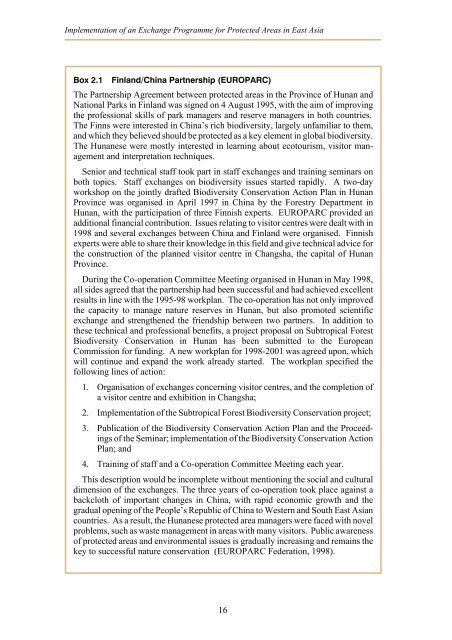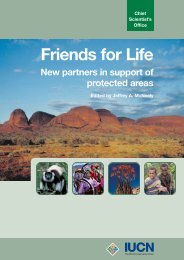Exchange programmes - IUCN
Exchange programmes - IUCN
Exchange programmes - IUCN
Create successful ePaper yourself
Turn your PDF publications into a flip-book with our unique Google optimized e-Paper software.
Implementation of an <strong>Exchange</strong> Programme for Protected Areas in East Asia<br />
Box 2.1 Finland/China Partnership (EUROPARC)<br />
The Partnership Agreement between protected areas in the Province of Hunan and<br />
National Parks in Finland was signed on 4 August 1995, with the aim of improving<br />
the professional skills of park managers and reserve managers in both countries.<br />
The Finns were interested in China’s rich biodiversity, largely unfamiliar to them,<br />
and which they believed should be protected as a key element in global biodiversity.<br />
The Hunanese were mostly interested in learningabout ecotourism, visitor management<br />
and interpretation techniques.<br />
Senior and technical staff took part in staff exchanges and training seminars on<br />
both topics. Staff exchanges on biodiversity issues started rapidly. A two-day<br />
workshop on the jointly drafted Biodiversity Conservation Action Plan in Hunan<br />
Province was organised in April 1997 in China by the Forestry Department in<br />
Hunan, with the participation of three Finnish experts. EUROPARC provided an<br />
additional financial contribution. Issues relatingto visitor centres were dealt with in<br />
1998 and several exchanges between China and Finland were organised. Finnish<br />
experts were able to share their knowledge in this field and give technical advice for<br />
the construction of the planned visitor centre in Changsha, the capital of Hunan<br />
Province.<br />
Duringthe Co-operation Committee Meetingorganised in Hunan in May 1998,<br />
all sides agreed that the partnership had been successful and had achieved excellent<br />
results in line with the 1995-98 workplan. The co-operation has not only improved<br />
the capacity to manage nature reserves in Hunan, but also promoted scientific<br />
exchange and strengthened the friendship between two partners. In addition to<br />
these technical and professional benefits, a project proposal on Subtropical Forest<br />
Biodiversity Conservation in Hunan has been submitted to the European<br />
Commission for funding. A new workplan for 1998-2001 was agreed upon, which<br />
will continue and expand the work already started. The workplan specified the<br />
followinglines of action:<br />
1. Organisation of exchanges concerning visitor centres, and the completion of<br />
a visitor centre and exhibition in Changsha;<br />
2. Implementation of the Subtropical Forest Biodiversity Conservation project;<br />
3. Publication of the Biodiversity Conservation Action Plan and the Proceedings<br />
of the Seminar; implementation of the Biodiversity Conservation Action<br />
Plan; and<br />
4. Trainingof staff and a Co-operation Committee Meetingeach year.<br />
This description would be incomplete without mentioningthe social and cultural<br />
dimension of the exchanges. The three years of co-operation took place against a<br />
backcloth of important changes in China, with rapid economic growth and the<br />
gradual opening of the People’s Republic of China to Western and South East Asian<br />
countries. As a result, the Hunanese protected area managers were faced with novel<br />
problems, such as waste management in areas with many visitors. Public awareness<br />
of protected areas and environmental issues is gradually increasing and remains the<br />
key to successful nature conservation (EUROPARC Federation, 1998).<br />
16






